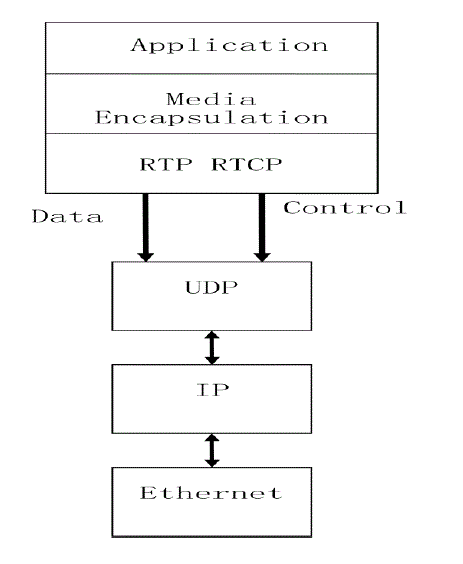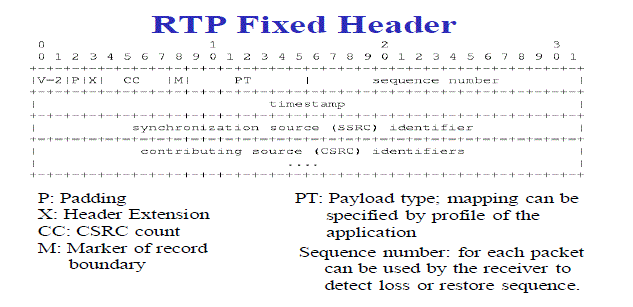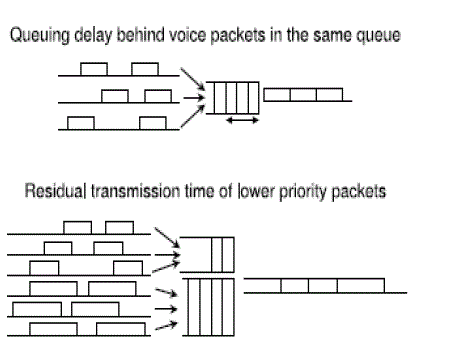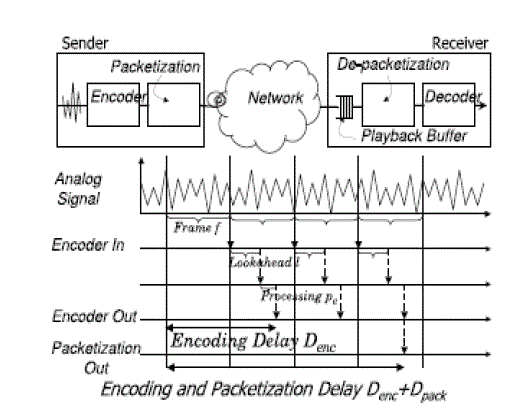The “EOIP; Every Thing Over IP“ networks are widely replacing today’s different pillar networks in to the single converged network for Telephony(Any type of Access i.e. Mobile or Fixed Line) and data. Definitely new services will be expected in the NGN / EOIP such as broadcast media transmission and video on demand. But one major issues are always from past so many years are associated with Internet Protocol regarding voice transmission is Quality because one of the basic property involves with voice transmission is it requires real time transmission without this it will losses its charm[8]. A major consideration with the NGN is that it provides an equivalent voice service quality and resiliency as the current telephone network. The analysis carried out for this paper looked that without making any real time arrangement in data network in case of IP network will definitely detorate the Quality of service. So arrangement of Real time is mandatory for network quality and QOS of voice .By using the RTP& RTCP as a Application Layer Signaling Control Protocol in EOIP network will ensure the bare minimum packet loss(pay load) for telephony. The scope of this paper will prove that real time application i.e. voice transmission if it sent over non real time network with RTP/RTCP(Application Layer Signaling Control Protocol) the quality increases & provides an equivalent voice service quality and resiliency as the current telephone network.
Keywords |
| EOIP, NGN, QOS, RTP, RTCP. |
INTRODUCTION |
| EOIP As per ITU “Everything Over IP”or more precisely NGN is a Packet based network which is able to provide
multimedia telecom services and able to use of multiple broad band, Qos enabled transport in which service related
functions are separate from underlying transport related technologies. The NGN concept takes into consideration new
realities in the telecommunication industry characterized by factors such as: the need to converge and optimize the
operating networks and the extraordinary expansion of digital traffic i.e., increasing demand for new multimedia services,
increasing demand for mobility, etc. The customers demand for new services is increasing and that too at less cost.
Therefore there is a need for a network which has a capability to develop services and able to extend it to the end user
independent of the other part of the network[3]. This is achieved through the concept of EOIP. The NGN is characterized
by the following fundamental aspects: |
| • Packet-based transfer |
| • Separation of control functions among bearer capabilities, call/session, and application/service |
| • Decoupling of service provision from transport, and provision of open interfaces |
| • Support for a wide range of services, applications and mechanisms based on service building blocks (including
real time/streaming/non-real time services and multi-media) |
| • Broadband capabilities with end-to-end QoS and transparency |
| • Interworking with legacy networks via open interfaces |
| • Generalised mobility |
| • Unfettered access by users to different service providers |
| • A variety of identification schemes which can be resolved to IP addresses for the purposes of routing in IP
networks |
| • Unified service characteristics for the same service as perceived by the user |
| • Converged services between Fixed and Mobile networks |
| • Independence of service-related functions from underlying transport technologies[2] . |
| A. RTP: RTP is real time transport protocol and it is developed basically for media transport in most of the NGN
applications although other Transport Layer protocols, in particular Datagram Congestion Control Protocol (DCCP)
and Stream Control Transmission Protocol (SCTP) may be used because of their congestion control mechanisms.
Transmission Control Protocol (TCP) has been documented for RTP usage, but is rarely deployed in such applications
[1]. Applications using RTP are less sensitive to packet loss, but typically very sensitive to delays resulting from
network latency, so UDP is a better choice than TCP for such applications. |
| • Payload-type identification - Indication of what kind of content is being carried |
| • Sequence numbering - PDU sequence number |
| • Time stamping - allow synchronization and jitter calculations |
| • Delivery monitoring[6] |
B. What is meant by real-time? |
| The class of methods whose correctness depends not only on whether the result is the correct one, but also on the time at
which the result is delivered. |
| To make things simpler, let’s take an example. Say you want to listen to a song. When you are downloading it from a site,
you don't care whether it is downloaded at the same rate or not. You just need a reliable download (preferably fast). But
what if want to listen to the song without downloading it? Then you are not only interested to get the whole data but also
the rate at which you receive, otherwise the song loses its charm. Here you need a real-time transmission.
Note that the example is given only to show how the time-factor is important in transmission of data. Real-time
transmission is more important in multimedia conferences. |
C. How RTP Works- |
| A header is attached to these RTP packets. These RTP packets are sent to UDP, where a UDP header is attached. The
combined packet is the sent to IP, where an IP header is attached and the resulting IP datagram is routed to the
destination.At the destination, the various headers are used to pass the packet to the appropriate application. |
| RTP can use many different voice and video coding standards (e.g. G.711 G.723, G.729,H261 etc.). RTP includes a
mechanism which allocates a payload type number to various coding schemes and provides high-level descriptions of the
coding techniques. Thus pay load data can be correctly interpreted at receiving end by knowing which coding scheme is
being used. |
RELATED WORK |
| The “EOIP; Every Thing Over IP“ networks are widely replacing today’s different pillar networks in to the single
converged network for Telephony(Any type of Access i.e. Mobile or Fixed Line) and data. At present we all are living
in the layers of different type of networks. The main disadvantage of this architecture is features. Services are duplicated
at each and every access point. Because we are not having Centralized control and distributed architecture. Definitely
new services will be expected in the NGG/EOIP such as broadcast media transmission and video on demand. But one
major issues are always from past so many years are associated with Internet Protocol regarding voice transmission is
Quality because one of the basic property involves with voice transmission is it requires real time transmission without
this it will losses its charm[8]. |
| So far a lot of research work has been carried out to focused on the VoIP stream which could be used for identifying the
stream using a timing based channel but no full proof method has been find out yet to ensure the reliability and qos of voice
transmission on real time network. A covert channel using the TCP timestamp was presented in “Covert Messaging
Through TCP Timestamps” [7]. This channel carried 1bit in the least significant bit of the TCP timestamp by delaying the
packet creation. It is essentially a timing channel, with the timing change read from the timestamp value. In TCP, the
timestamp is only an option, making it easier to detect if a system does not usually use the option. In contrast, RTP makes
use of the timestamp in every packet. The TCP timestamp is set from the system clock, but has no set unit of measure
(varies by operating system)[9]. |
PROBLEM IDENTIFICATION |
| The major drawback of this existing network architecture is features. Services are duplicated at each and every access
point. Because we are not having Centralized control and distributed architecture. Definitely new services will be
expected in the NGN / EOIP such as broadcast media transmission and video on demand. But one major issues are
always from past so many years are associated with Internet Protocol regarding voice Transmission[5]. |
PROPOSED WORK |
| This paper concentrates on improving network quality specially when we send the real time application such as voice over a
non real time network i.e. IP network. To identify this and to sort out the solution RTP & RTCP protocol will be deployed
in between the two NGN nodes can be Trunk Media Gateways through the VTCA system and traffic will be generated and
sent over this IP based network. Through the analysis software it will be identified with the help of RTP/RTCP how much
packet loss / delay / jitter reduced up to much extent and the quality increases & provides an equivalent excellent voice
service quality and resiliency as the current telephony network. The analysis will be carried out that without making any real time arrangement in data network in case of IP network will definitely detorate the Quality of service. So arrangement
of Real time is mandatory for network quality and QOS of voice .By using the RTP& RTCP as a Application Layer
Signaling Control Protocol in EOIP network will ensure the bare minimum packet loss(pay load) for telephony. Timing
information: sampling period. |
| We can focus on networks where a queue for voice traffic is provided. In this context, we have first described the
particularity of voice traffic as compared to other traffic on the network i.e. real time need analysis fig 3 . We can show the
importance of bandwidth to reduce the delay percentile incurred by voice in a network, and concluded that network delay
becomes a negligible portion of end-to-end delay in case available bandwidth exceeds 10 Mbit/s.(Between Media Gateway
to Media Gateway) and after that we can compare different scheduling schemes (that is, PQ, Priority Queuing, WRR
Weighted Round Robin and the provision of different circuit for voice traffic), and can show that PQ leads to the best
compromise between bandwidth utilization and delay minimization, as long as the preemption of non-real time voice
packets is implemented on sub-10 Mbit/s links. In last we can analyze the
effect of packet size on voice delay and bandwidth utilization, and showed that a packet formation time of 30 ms for
G.729A and G.723.1 (that is, a packet size of 30 and 20 bytes, respectively) and 10 ms for G.711 (that is, a packet size of
80 bytes) constitute a good compromise between low delay and efficient network utilization. |
CONCLUSION |
| The conclusion of this paper is that RTP defines transport support for common functions of real-time applications. So
provision of Real time is quality demand for network and for quality grade service of voice .By using the RTP& RTCP as a
Application Layer Signaling Control Protocol in EOIP network will ensure the bare minimum packet loss(pay load) for
telephony. Timing information: sampling period. . |
Tables at a glance |
 |
| Table 1 |
|
Figures at a glance |
 |
 |
 |
 |
| Figure 1 |
Figure 2 |
Figure 3 |
Figure 4 |
|
References |
- Alipio BC, David FC, Isabel RS, Juan CNM. Manuel AE. Comparison of batch, stirred flow chamber, and column experiments to study adsorption, Desorption and transport of carbofuran within two acidic soils. Chemosphere. 2012; 88(1): 106-120.
- Arnaud B, Richard C, Michel S. A comparison of five pesticides adsorption and Desorption processes in thirteen contrasting field soils. Chemosphere. 2005; 61(5): 668-676.
- Chunxian W, Jin-Jun W, Su-Zhi Z, Zhong-Ming Z. Adsorption and Desorption of Methiopyrsulfuron in Soils. Pedosphere. 2011; 21(3): 380-388.
- Chunxian W, Suzhi Z, Guo N, Zhongming Z, Jinjun W. Adsorption and Desorption of herbicide monosulfuron-ester in Chinese soils. J Environ Sci. 2011; 23(9): 1524-1532.
- Christine MFB, Josette MF. Adsorption-desorption and leaching of phenylurea herbicides on soils. Talanta. 1996; 43(10): 1793-1802.
|